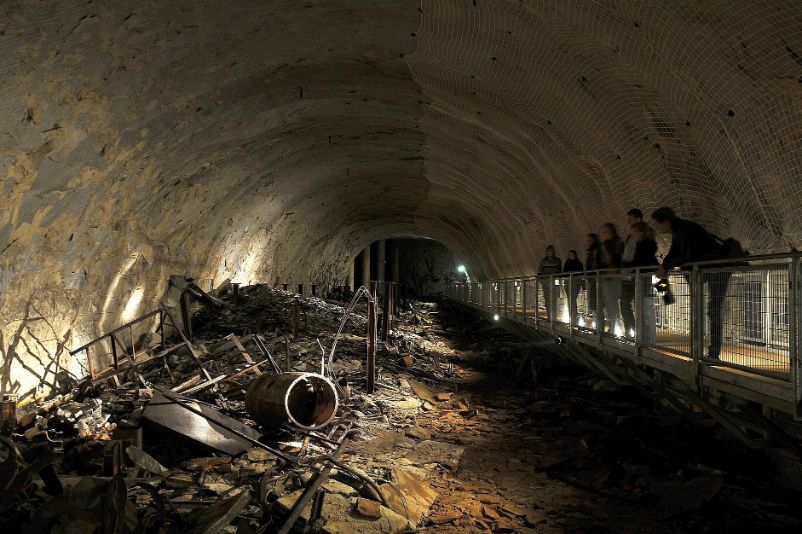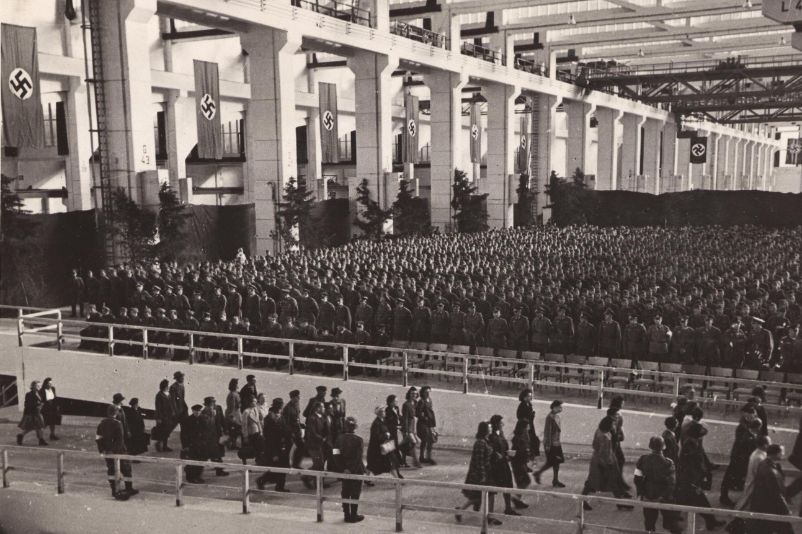
Forced labour was a defining component of concentration camp detention from the very beginning. Initially used as a harassing means of punishment and "education", the SS soon sought to make financial gains through merciless exploitation. In the second half of the war, the SS switched to hiring out prisoners as forced labourers to the armaments industry. The prisoners were supposed to help avert the threat of defeat in the war. Between 1942 and 1945, about 1,000 subcamps were set up at industrial enterprises and construction projects.

Forced labour of concentration camp prisoners did not take place in secret. Rather, treatment norms were established here that also found acceptance when applied to the millions of prisoners of war and civilian forced labourers after 1939. These included, above all, the strict hierarchisation of those affected according to racist criteria, the constant selection according to ability to work and the strict spatial separation of the different groups. The use of concentration camp prisoners reveals most drastically that forced labour often had fatal consequences.
The seminar Forced Labour and Concentration Camps focuses on three historical focal points:
- Change in function of forced labour of concentration camp prisoners: from a means of "education" to an attempt to make economic profits to the "last reserve" of a declining war economy
- Link between concentration camp forced labour and other forms of forced labour: the ruthless use of forced labourers in all sectors using specifically Nazi principles - a key characteristic of the German economy in World War II
- Participation of the whole of German society in the crime of "forced labour": unquestioning acceptance and daily practice in the use of forced labourers under ideologically shaped conditions - the system-stabilising effect of forced labour in the sense of strengthening the so-called "Volksgemeinschaft".
The contents of the seminar can be experienced at three historical sites. They provide particularly vivid insights into how Nazi society functioned.
- Buchenwald/Weimar stands for the construction phase of the concentration camps, for the development of forced labour in the concentration camps from terror to an attempt to achieve economic gain, and for the associated inclusion of ever wider circles of the population.
- The Mittelbau-Dora concentration camp uses the example of the relocation of armament production underground to show the intention to overcome wartime economic bottlenecks without regard for the lives and health of the concentration camp forced labourers.
- The "concentration camp landscape" in the southern Harz symbolises the omnipresence of forced labour in German wartime society with concentration camp subcamps, prisoner of war commands and camps for foreign civilian workers existing side by side.
In Buchenwald/Weimar, Mittelbau-Dora and the southern Harz there are characteristic sites for each of the different themes. The quarry in Buchenwald, for example, shows the dominance of "education" in the early phase of the concentration camp, while the Gustloff-Werke I (Weimar) and II (Buchenwald) illustrate both the - ultimately unsuccessful - attempt to economise prisoner labour and the participation of many Germans. Finally, the Small Camp points to the change in function and the use of prisoners in the satellite camps of the war economy. In Mittelbau-Dora, the tunnel complex in the Kohnstein is a striking example of the recklessness with which human lives were sacrificed in order to maintain the illusion of confidence in victory, and of the failed attempt to have prisoners carry out skilled work for the armaments industry without changing the murderous conditions of existence. Finally, the journey through the "concentration camp landscape" in the southern Harz region makes visible the omnipresence of all forms of forced labour in German wartime society. At all stations, the questions are linked to the historical record (documents, photos, eyewitness accounts, found objects, worksheets) using concrete examples in order to convey the learning objectives in an age-appropriate and participant-oriented manner.
Day 1
Morning:
- Arrival in Weimar
- Opening of the seminar at the Buchenwald memorial site
- First guided tour of the memorial site (from the former railway station to the camp gate to the roll call square and to other places in the former prisoners' camp)
Afternoon:
- Introductory film on the history of Buchenwald Concentration Camp.
- Lecture on the history of the camp using a model
- Second guided tour of the memorial site (prisoners' quarter, small camp, detention cell building and crematorium)
Evening:
- Discussion on individual topics, use of the documentation and digital collections for individual research
- Overnight stay at the Buchenwald Youth Meeting Centre
Day 2
Morning:
- Visit to the sites of forced labour in Buchenwald (quarry, Gustloff works, SS area).
- Visit to the permanent exhibition at the memorial
- Evaluation discussion
Afternoon:
- Trip from the Buchenwald memorial to the Mittelbau-Dora concentration camp memorial, Nordhausen.
Evening:
- Guided tour of the Mittelbau-Dora concentration camp memorial and the Kohnstein tunnels.
- Overnight stay in Nordhausen
Day 3
Morning:
- Drive through the "concentration camp landscape" in the southern Harz region (commented bus tour with stops at several stations of former camps of the Mittelbau concentration camp complex).
- Lunch break along the way
Afternoon:
- Continuation of the journey to the former camp for the dying of the Mittelbau concentration camp, the "Boelcke Barracks" in Nordhausen.
- Overnight stay in Nordhausen
Day 4
Morning:
- Evaluation of the trip and enrichment of impressions through document viewing at the Mittelbau-Dora concentration camp memorial.
- Visit to the permanent exhibition of the memorial
Afternoon:
- Seminar evaluation and conclusion
The sample seminar lasts four days. Depending on the wishes of the group, the programme can also be supplemented with further modules, so that it could comprise five days or more. The minimum duration of the seminar on forced labour and concentration camps is three days.
Modules can be tailored to different learning requirements and age levels.
Information & registration:
Accommodation will initially be provided at the Buchenwald Youth Meeting Centre, and in Nordhausen at the Rothleimmühle Youth Guest and Education House (in each case single rooms, double rooms, shared rooms). The seminar costs include travel to and from Buchenwald, transfers from Buchenwald to Mittelbau-Dora and to the satellite camp sites, as well as accommodation and meals. The optimum number of participants is between 15 and 25. The seminar is aimed at interested persons who already have general knowledge of the topic of Nazi concentration camps and want to work more in-depth on the topic of forced labour. The seminar will be adapted to the level of knowledge of the participants. It can be offered to pupils as well as in the context of adult education or as further training for multipliers.
The seminar was developed as part of the international touring exhibition "Forced Labour under National Socialism", funded by the Foundation "Remembrance, Responsibility and Future".

